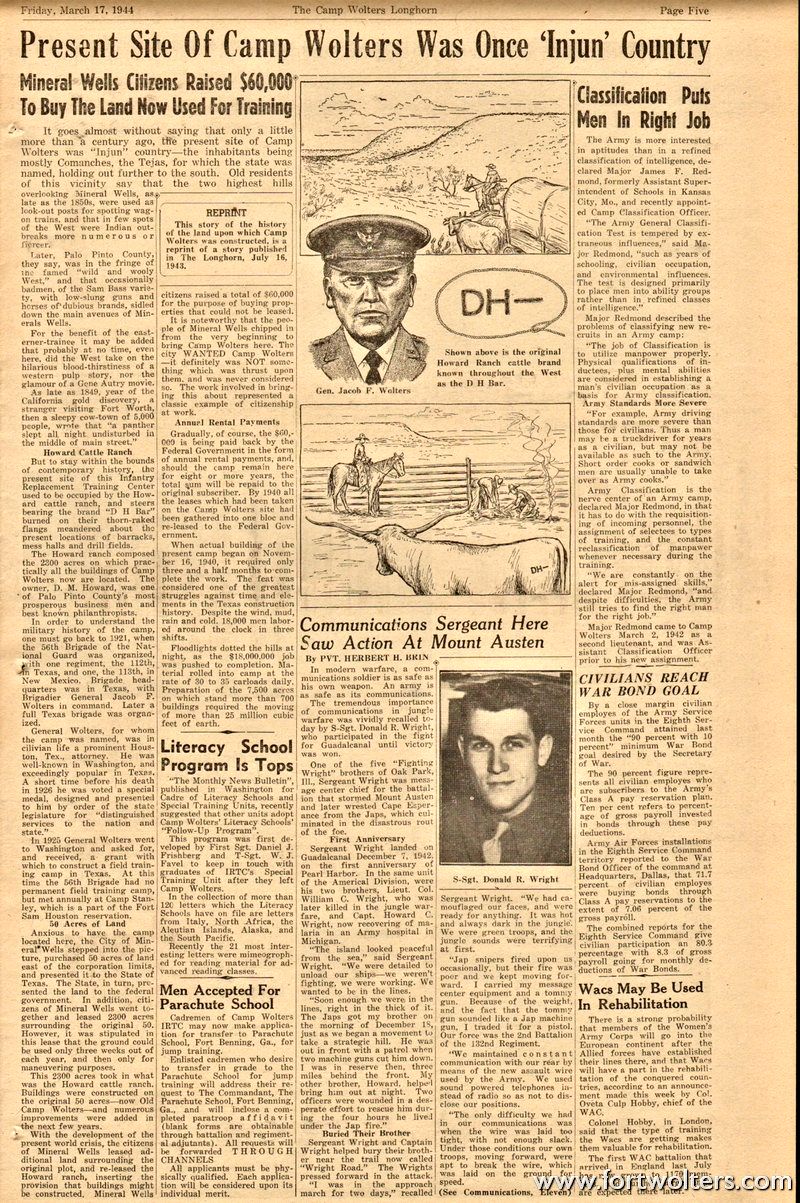Present Site Of Camp Wolters Was Once 'Injun' Country
Mineral Wells Citizens Raised $60,000 To Buy The Land Now Used For Training.
It goes almost without saying that only a little more than a century ago, the present site of Camp Wolters was "Injun" country—the inhabitant-s being mostly Comanches, the Tejas, for which the state was named, holding out further to the south. Old residents of this vicinity say that the two highest hills overlooking Mineral Wells, as late as the 1850s, were used as look-out posts for spotting wagon trains, and that in few spots of the West were Indian out-breaks more numerous or fiercer.
Later, Palo Pinto County, they say, was in the fringe of the famed "wild and wooly West," and that occasionally bad men, of the Sam Bass variety, with low-slung guns and horses of’ dubious brands, sidled down the main avenues of Minerals Wells.
For the benefit of the easterner-trainee it may be added that probably at no time, even here, did the West take on the hilarious blood-thirstiness of a western pulp story, nor the glamour of a Gene Autry movie. As late as 1849, year of the California gold discovery, a stranger visiting Fort Worth, then a sleepy cow-town of 5,000 people, wrote that "a panther slept all night undisturbed in the middle of main street."
Howard Cattle Ranch
But to stay within the bounds of contemporary history, the present site of this Infantry Replacement Training Center used to be occupied by the Howard cattle ranch, and steers having ring the brand "D II Bar" burned on their thorn-raked flanks meandered about the present locations of barracks, mess halls and drill fields.
The Howard ranch composed the 2300 acres on which practically all the buildings of Camp Wolters now are located. The owner, D. M. Howard, was one of Palo Pinto County's most prosperous business men and best known philanthropists.
In order to understand the military history of the camp, one must go back to 1921, when the 56th Brigade of the National Guard was organized, with one regiment, the 112th, a Texas, and one, the 113th, in New Mexico. Brigade headquarters was in Texas, with Brigadier General Jacob F. Wolters in command. Later a full Texas brigade was organized.
General Wolters, for whom the camp was named, was in civilian life a prominent Houston, Tex. attorney. He was well-known in Washington, and exceedingly popular in Texas. A short time before his death in 1926 he was voted a special; medal, designed and presented to him by order of the state legislature for "distinguished services to the nation and state."
In 1925 General Wolters went to Washington and asked for, and received, a grant with which to construct a field training camp in Texas. At this time the 56th Brigade had no permanent field training camp, but met annually at Camp Stanley, which is a part of the Fort Sam Houston reservation.
50 Acres of Land
Anxious to have the camp located here, the City of Mineral Wells stepped into the picture, purchased 50 acres of land east of the corporation limits, and presented it to the State of Texas. The State, in turn, presented the land to the federal government. In addition, citizens of Mineral Wells went together and leased 2300 acres surrounding the original 50. However, it was stipulated in this lease that the ground could be used only three weeks out of each year, and then only for maneuvering purposes.
This 2300 acres took in what was the Howard cattle ranch. Buildings were constructed on the original 50 acres - now Old Camp Walters - and numerous improvements were added in the next few years.
With the development of the present world crisis, the citizens of Mineral Wells leased additional land surrounding the original plot, and re-leased the Howard ranch, inserting the provision that buildings might be constructed, Mineral Wells citizens raised a total of $60,000 for the purpose of buying properties that could not he leased.
It is noteworthy that the people of Mineral Wells chipped in from the very beginning to bring Camp Wolters here. The city WANTED Camp Wolters —it definitely was NOT something which was thrust upon them, and was never considered so. The work involved in bringing this about represented a classic example of citizenship at work.
Annual Rental Payments
Gradually, of course, the $60,000 is being paid back by the Federal Government in the form of annual rental payments, and. should the camp remain here for eight or more years, the total sum will be repaid to the original subscriber. By 1940 all the leases which had been taken on the Camp Wolters site had been gathered into one bloc and re-leased to the Federal Government.
When actual building of the present camp began on November 16, 1940, it required only three and a half months to complete the work. The feat was considered one of the greatest struggles against time and elements in the Texas construction history. Despite the wind, mud, rain and cold, 18,000 men labored around the clock in three shifts.
Floodlights dotted the hills at night as the $18,000,000 job was pushed to completion. Material rolled into camp at the rate of 30 to 35 carloads daily. Preparation of the 7,500 acres on which stand more than 700 buildings required the moving of more than 25 million cubic feet of earth. |

